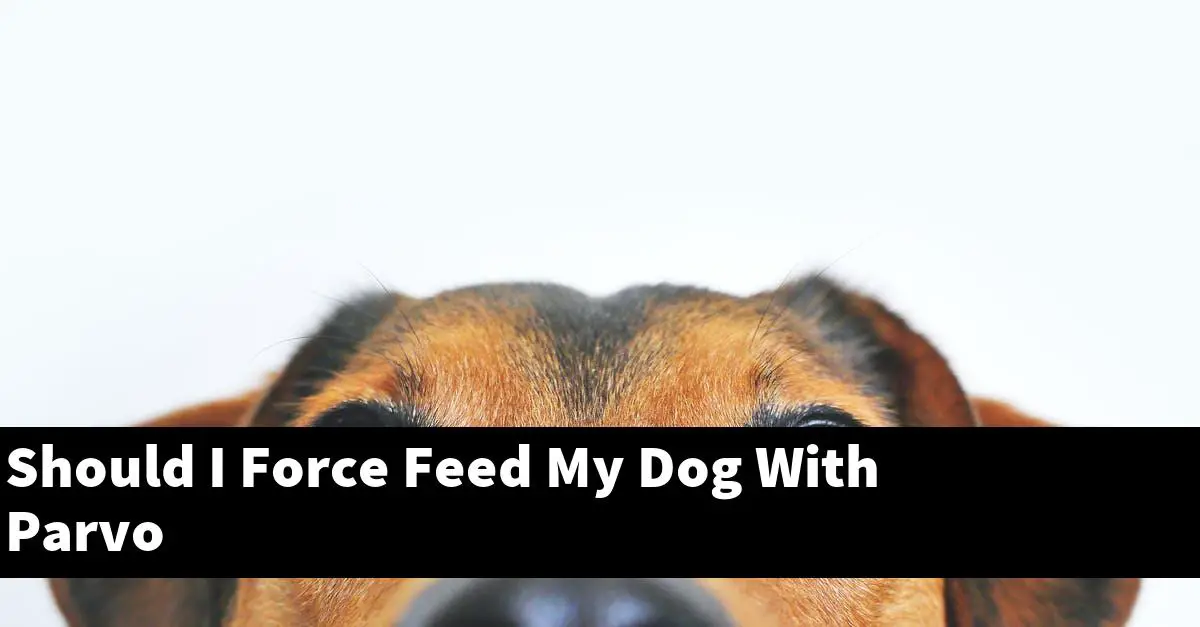Is force-feeding your dog with parvo the right thing to do?
If your dog is infected with Parvovirus, also known as “parvo,” you may be wondering if you should force-feed your dog. The answer is generally no. While it is important to keep your dog hydrated, forcing food and water into your dog’s mouth can actually make the situation worse.
The article covers the pros and cons of force-feeding a dog with parvo.
Table of Contents
What are the symptoms of parvo in dogs?
The symptoms of parvo in dogs are vomiting, diarrhea, lethargy, and loss of appetite. The virus affects the gastrointestinal tract and can cause severe dehydration.
Puppies and young dogs are most susceptible to the virus, and it can be deadly if not treated quickly. Early symptoms include vomiting and diarrhea, which can lead to dehydration and anorexia. As the disease progresses, dogs may develop a fever, lethargy, and a decrease in white blood cells.
Treatment for parvo includes aggressive hydration, antibiotics, and supportive care. Puppies and dogs with parvo should be isolated from other animals to prevent the spread of the virus.
How is parvo transmitted?
Canine parvovirus (CPV) is a highly contagious viral disease that can affect dogs of all ages, but is most common in puppies.
The virus is shed in the feces of infected dogs and can be spread through direct contact with contaminated feces, or through contact with contaminated surfaces (such as food bowls, crates, or the ground in areas where infected dogs have been). It can also be spread indirectly, through contact with people or other animals that have been in contact with contaminated surfaces.
CPV is most commonly spread through contact with infected feces. The virus can be spread through direct contact with contaminated feces, or through contact with contaminated surfaces (such as food bowls, crates, or the ground in areas where infected dogs have been). It can also be spread indirectly, through contact with people or other animals that have been in contact with contaminated surfaces.
Puppies are especially vulnerable to CPV because their immune systems are not fully developed. The virus can cause severe intestinal damage and can be fatal if not treated promptly and aggressively. Treatment typically includes hospitalization, intensive supportive care, and administration of antiviral and immunomodulatory drugs.
There is no specific cure for CPV, and the virus can remain in the environment for long periods of time. Therefore, prevention is the best way to protect your dog from this disease. Vaccination is the most effective method of prevention, and all puppies should be vaccinated against CPV starting at 6-8 weeks of age.
How long does it take for symptoms of parvo to appear in dogs?
The symptoms of parvo in dogs usually appear within 3-10 days after the dog is infected with the virus. The first symptoms are usually fever, lethargy, and vomiting. Diarrhea usually follows within a few days and can be bloody.
Dehydration from vomiting and diarrhea is the most common cause of death in dogs with parvo. Treatment is aimed at preventing dehydration and supporting the dog’s immune system.
What is the treatment for parvo in dogs?
The treatment for parvo in dogs is typically done through a course of antibiotics. The most common antibiotics used to treat parvo are doxycycline and amoxicillin. However, there are other antibiotics that may be used as well.
The course of antibiotics will typically last for about two weeks. During this time, it is important to keep your dog hydrated. This can be done by giving them small amounts of water frequently or by giving them an electrolyte solution. It is also important to keep your dog away from other dogs, as they can easily spread the infection.
How can I force my dog to eat with parvo?
If your dog has parvo, you may be wondering how you can get them to eat. Parvo is a virus that attacks the gastrointestinal system, causing vomiting and diarrhea. This can lead to dehydration and weight loss, so it’s important to get your dog to eat and drink if they have parvo.
There are a few things you can do to encourage your dog to eat. First, try offering them small meals more often throughout the day instead of one large meal. This will be easier on their stomach and may help them keep food down. You can also try feeding them canned food or cooked chicken instead of dry food. Adding a little water to their food can also help them stay hydrated.
If your dog is still not eating, you may need to take them to the vet. They may need to be hospitalized and given fluids and nutrients intravenously. With treatment, most dogs with parvo recover fully.
How long can a dog with parvo go without eating?
How long can a dog with parvo go without eating?
A dog with parvo can go without eating for a few days, but will eventually need to eat in order to survive. If a dog with parvo does not eat, it will become weak and may eventually die.
Is it okay to force-feed a dog with parvo?
No, it is not okay to force-feed a dog with parvo. Parvo is a highly contagious virus that can cause severe vomiting and diarrhea in dogs. If a dog is not treated promptly, it can lead to dehydration and death.
What is the best thing to feed a dog with parvo?
The best thing to feed a dog with parvo is a high-quality, easily digestible diet that is rich in protein and low in fat.
Puppies with parvo should be fed small meals frequently throughout the day to avoid overwhelming their sensitive stomachs. A bland diet of boiled rice and chicken or cottage cheese and rice is often recommended for dogs with parvo, as these foods are easy to digest and provide the nutrients your puppy needs to recover.
Conclusion
No, you should not force-feed your dog with parvo. If your dog has parvo, the best thing you can do is take him to the vet immediately. There is no cure for parvo, but the vet can give your dog fluids and medication to help relieve his symptoms and make him more comfortable.


